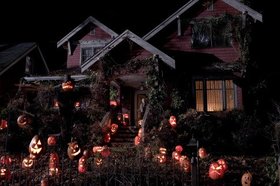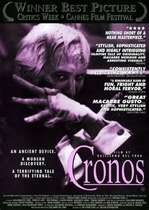Our editor-in-chief Nate Yapp is proud to have contributed to the new book Hidden Horror: A Celebration of 101 Underrated and Overlooked Fright Flicks, edited by Aaron Christensen. Another contributors include Anthony Timpone, B.J. Colangelo, Dave Alexander, Classic-Horror.com's own Robert C. Ring and John W. Bowen. Pick up a copy today from Amazon.com!
The Disused Fane: Night and Day of the Dead
One Halloween night when I was a teenager a friend and I decided to walk to the cemetery a quarter mile from my mom's apartment and wander around. It was pretty spooky. The cemetery in question was huge, with a dead gnarled tree near the entrance, and odd little stone steps - we imagined that they were perhaps gateways to Hell - leading from the pathways to the fields where hundreds of gravestones sprawled. One almost expected to see Colin Clive and Dwight Frye skulking about with shovel and lantern. Another friend of ours had declined to come. He was quite religious, and what we were doing he found both offensive and frightening, regarding it disrespectful of the dead and vaguely "evil" as well. As the two of us got increasingly creeped out I suggested that we should have forced the third guy to come with us - if we were attacked by angry specters, I said, we could have ritualistically sacrificed him to placate them. But seriously, with Samhain, All Saints' Day, and El Día de los Muertos just behind us, perhaps we ought to devote a few thoughts to the spirits of the departed. After all, most of us have spent at least part of the last week honoring them.
Across cultures we can find references to holidays of the dead at this time of year. The festival of Samhain from the religion of the Gaelic Celts is a fine example of one, and particularly relevant to horror fans, as it remains the primary inspiration for the modern Halloween. This was elucidated in Trick 'r Treat (2008). In that recent but gloriously old-fashioned film, an eccentric girl lectures a group of other kids about the ancient traditions of Samhain. This period between autumn and winter, when plants and insects die off en masse, when crops are brought in for harvest, and when the dark half of the year begins, was thought to be the time when the boundary between the realm of the living and the realm of the dead grew thinnest. And if the dead decide to visit us, we'd best be prepared to receive them. In the movie, unsurprisingly, it is the girl who knows all this and who respects the old traditions who fares best when the unquiet dead do show up. Those who don't know better fare far worse. The other kids' fate resembles that of the mortals who, on Samhain, were said to have been tricked into crossing over into the otherworld, never to return. Or perhaps it better resembles that of the animals deemed unfit to make it through the "dark half" of the year: sacrificially slaughtered and consumed as part of the festivities. Later in Trick 'r Treat a crotchety old man makes the mistake of not handing out treats. Calling what he experiences as a result a "trick" might be putting it mildly. But it's all there in the old tradition. The Celts used to leave food on their doorsteps for any uninvited Samhain guests.1
And then there's the jack-o-lantern. Who can forget the simple, yet eerie opening shot of Halloween (1978), lingering on a leering face carved into a pumpkin that glows from within? Lanterns made from hollowed-out turnips (pumpkins being an American gourd) were set out on Samhain to frighten off evil spirits.2 Unfortunately for Laurie Strode and her friends, however, this seems not to have worked, as the evil spirit who manifests in Haddonfield is incapable of being placated. "The Shape" thus sets about the grim work of transforming the living into the dead. While wearing a mask, no less. Costumes too were part of the general Samhain chaos, the blurring of the identity of the wearer running parallel to the blurring of the boundary between living and dead. Michael Myers seems to have no life outside of killing; Dr. Loomis remarks on his "devil's eyes" and "pure evil". Perhaps, then, the mask is redundant, and Myers is simply an evil spirit, escaped from the netherworld, who on Halloween roams the streets costumed as a man.
When Christianity spread to northwestern Europe, the Church, as it often did when encountering pagan traditions, did not so much stamp out Samhain as subsumed it. It became "All Hallow's Eve", preceding All Saints' Day and All Souls' Day (a.k.a. the Day of the Dead), two holy days given to commemorating the departed - both those who have reached Heaven and those who are still languishing in Purgatory. In Christian tradition, prayers on behalf of these souls are believed to help move them onwards to God's embrace. Therefore, despite the change in religions, the basic idea is the same: when winter's shadow begins to loom, the dead demand attention.
Our modern, secularized version of Halloween retains the trappings of old. People dress as murder victims, hang up decorations resembling ghosts, give up offerings of food, and watch movies (or even children's holiday specials) filled with darkness and death. My friend and I, walking through the graveyard on Halloween years ago, were probably not so much desecrating the resting place of the deceased as paying homage to them, in their place, on the night that belongs to them.









I've just spent half an hour
I've just spent half an hour writing a response, and the system wouldn't let me post it. Let's see if it works now.
Yes, it seems to work! I am a
Yes, it seems to work!
I am a contemporary pagan; I did my Samhain ceremony at dusk (that most liminal of times) when the boundaries between the worlds are at their thinnest.
(This is a precis of what I had originally written, which I can't retrieve from the system. Apologies!)
It's a curious thing that in the UK, the Pagan festival of Samhain has been split up over a fortnight of separate ceremonies. Last weekend we had Samhain, or Halloween. The ancient Pagan Fire festivals have been continued but shifted to Bonfire Night, ostensibly in recognition of the early 17th century plot against monarchy and pariliament,which allows the lighting of fires, the setting off of fireworks, and the burning of evil in effigy. A few days after that comes Remembrance Sunday,the recognition of the 'honourable dead', at which the Queen and prime MJinister lay wreaths in public to honour those who died in the World Wars. These are the three aspects of Samhain, divided up between three interlinked occasions.
Sorry that this is just the bare bones of my original essay, and the system won't let me go back and correct any typos.!